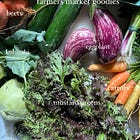raising real food kids in a processed world
A Functional Nutrition Counselor's Perspective by Karina Baloleanu, CFNC
Big news – I am currently immersed in Natural Products Expo West in Anaheim, California! This massive convention is where thousands of food, beverage, and supplement brands showcase their latest innovations to buyers, nutritionists, specialty retailers, and wellness professionals.
Exciting news for my paid subscribers – I'll be selecting TWO of you to receive curated sample boxes filled with my favorite discoveries from the show! Keep an eye on Thursday's chat for the drawing details. I will also be writing up a detailed post showcasing all my favorite new finds, emerging brands, and the most delicious, exciting minimally processed healthy foods I discover. Consider it your insider's guide to what's next in the world of clean eating! If you're curious about what to expect, check out my recap from last year's Expo West to see my top 50 healthy finds!
While I am walking the acres of products, reading thousands of labels, talking to makers and founders at the convention this week, I have invited the wonderful
, to take the reins. Karina and I connected through Instagram initially, and I was immediately drawn to her philosophy on children's nutrition that so perfectly aligns with mine. If you missed my Q and A with Karina, you can read it here. You're in excellent hands! Enjoy Karina (and my own) perspective on feeding children.from Karina Baloleanu:
Ever since I became a mom, nutrition has taken on a whole new meaning. It's no longer just something I'm passionate about or something I do to optimize my health and help my clients. It's become something much bigger - a part of the legacy I want to leave my daughter with.
I believe that learning to listen to and understand your body as well as knowing how and what to eat are some of the most valuable life skills a person can learn. This should be taught in schools - it's that essential. What we eat doesn’t just shape our own health; it influences our children’s well-being and the generations that follow.
The Mindset Shift
Whenever people hear me say that my daughter, who is now almost five years old, doesn't drink juice or eat store-bought candy, or that she's never had Nutella or a Kinder Surprise, the first thought on their minds is, "But don't you feel that she's losing some of the joy of childhood?"
And here's the thing—it requires a mindset shift. I don’t think of it as my daughter losing something, but rather as what she’s gaining. She’s gaining nutrients that will fuel her cells and make her body strong and resilient. She’s gaining stable energy and mood. She’s gaining the foundation for lifelong health.
It’s easy to feel societal pressure to let kids indulge in sugary treats and processed foods "like everyone else," but I try to remember that the well-being I’m fostering in her is far more valuable than conforming to trends or expectations. It can feel isolating at times, but I know that in the long run, I’m giving her the best possible foundation for health.
This mindset shift is fundamental to making any changes. If you see it as depriving your kids of something, they will perceive it the same. That’s why in our house we never say, "We can't eat that," but rather, "We don't eat that." It changes the perspective from restriction to choice.
It’s also important to implement changes for the whole family. It shouldn't be just the kids who eat healthy—the entire family should. If you tell your kids they can’t have chips or ice cream, but you still eat them, it creates confusion and resistance. The first step in helping your kids eat a whole-food, nutrient-dense diet is for you to lead by example.
How meals look in our household
One of the things I care about deeply is eating meals together, as a family. We make it a priority to wake up early for breakfast and sit down for dinner to talk about our day. I’ve come to appreciate that meals are about so much more than just food on a plate—and it's something I learned best after moving to Spain. Here, meals aren’t just about eating; they’re about connection, community, and togetherness. Even after the last bite, people linger at the table for hours, laughing, sharing stories, and playing games.
Another important aspect is that we all eat the same food—there’s no separate "kids' menu." If I know my daughter isn’t fond of a certain ingredient, I serve her a deconstructed version of the meal, still including that ingredient but separately and in smaller amounts.
Normalizing kids' meals as smaller versions of adult meals
Cook in front of them, cook with them—let them be involved as much as possible. Yes, it will be messy. Yes, it will take longer. But these hands-on experiences help build a healthy relationship with food. Let them touch, taste, and smell different ingredients.
Have them help with dinner prep and let them snack on the veggies (this is the easiest way to get them to eat fiber first!). Cooking at home as much as possible is an investment in their future health. When my brother-in-law once asked me, "How can you cook so much?" my immediate thought was, "How could I not?"
Let them in the kitchen
Start small and sustainable. You don’t have to overhaul your entire life overnight. Focus on one habit at a time—whether it’s drinking more water, adding protein to meals, or getting more movement in your day. The key is consistency, not perfection.
Talk to them about food
For as long as I can remember, I’ve talked to my daughter about what and how we cook, where food comes from, and what’s on her plate. I’ve taken her grocery shopping with me, explaining why we choose one product over another—all in ways that make sense for her age. Don’t underestimate the power of talking to kids about food. They understand more than we give them credit for.
Repeated Exposure > Hiding Vegetables
Kids' tastes naturally change. My daughter loved avocado as a baby and toddler, then refused it for a long time, only to recently eat half a large avocado by herself. The key is exposure—consistent exposure without forcing or insisting.
It can take more than 30 exposures for a child to accept a certain food. For nearly three years, we consistently offered leafy greens at every meal without pressure. One day, she said yes to trying it. She’s still not an avid salad eater, but she will occasionally eat it, and that’s enough for me.
I’m also not a big fan of hiding vegetables in food. While it might work with younger kids, it can break trust as they get older. Plus, it robs them of the opportunity to develop a taste for that vegetable on its own. Instead, I prefer preparing veggies in different ways, using spices to enhance their flavor, or making a clean, nutrient-dense sauce they can dip their veggie sticks into or drizzle over a bowl.
Postponing sugar introduction as much as possible
Babies and young children naturally prefer sweet flavors, starting with breast milk. However, this preference begins to fade between ages 3 to 6 as taste buds develop—unless their diet is dominated by processed, high-sugar foods, in which case, the preference lingers.
To expand their palate, introduce a variety of flavors early on:
Bitter foods: citrus, green apples, cranberries, dark leafy greens
Fermented foods: sauerkraut, kimchi, kefir, plain yogurt
Herbs and spices: turmeric, cinnamon, parsley, ginger, basil
Umami-rich foods: bone broth, mushrooms, miso, eggs
I postponed introducing refined sugar for as long as possible, and I still opt for unrefined alternatives like maple syrup, raw honey (for kids aged one and older), dates, or bananas. Now, while my daughter enjoys cake at a birthday party, she still asks for fruit for "dessert."
Sugar is a huge topic—I could talk endlessly about it. We often associate it with cavities, but its effects go far beyond that. Regular or high consumption of sugar:
Depletes essential minerals: Sugar requires minerals like magnesium, calcium, and zinc to be metabolized, pulling them from the body.
Weakens the immune system: Just one teaspoon of sugar can suppress immune function for up to five hours, making us more prone to colds and illnesses.
Impacts gut health and brain function: It impacts gut health, which is directly connected to the brain, affecting focus, mood, and energy levels.
Disrupts blood sugar balance: Frequent sugar spikes and crashes can lead to fatigue, irritability, and cravings.
Fat + Fiber + Protein: The Trifecta for Balanced Meals
Every meal in our home includes fat, fiber, and protein. This ensures balanced energy and stable blood sugar. A nutrient-dense breakfast sets the foundation for the day, ensuring a milder blood sugar response, no matter what she eats later in the day.
I follow the same rule for snacks, and look to pair carbs with protein or fat. So, instead of an apple, I serve her apple slices with peanut butter, or instead of grapes, I serve parmesan slices and grapes.
Where to start if your family has been eating the standard American diet
If your older kids have been eating a processed-food-heavy diet, know that it’s never too late to start. Here’s where to begin:
Make your home a "safe space"
Choosing the food you bring into your home is the first step toward a sustainable, healthier lifestyle. Make your home a safe space where you or your kids don't have to exercise constant self-control, avoiding the snack drawer or that bag of potato chips. Make sure the food you buy and bring home is as nutritious as possible.
Crowd it out
Instead of completely removing certain foods and making it feel like a restriction, start by adding in healthy foods, one by one. The more healthy foods and habits we add in, the less space there will be for unhealthy habits and ultra-processed foods.
Start low and go slow
Start with small, simple swaps. Try finding a blood sugar-balanced version of their favorite meals—Beth is my go-to for that, whether it’s her No Oats recipe for breakfast, pancakes, or even lunch and dinner ideas.
Swap out basic ingredients where you can. Use almond or coconut flour instead of refined wheat flour, or mix white rice with cauliflower rice (50/50) for added fiber and a better glucose response. Replace fruit juice with coconut water, serve a fruit salad instead of cookies for dessert, or swap wheat crackers for seed crackers.
If you want to remove sugary, flavored yogurts from your kid’s diet, for example, don’t switch to plain yogurt overnight—they’ll likely refuse it. Instead, start by serving plain yogurt with fresh or frozen fruit and a drizzle of raw honey or maple syrup. Over time, as their taste buds adjust, gradually reduce the sweetener until they enjoy plain yogurt with just fruit.
Plan meals in advance
The system I use—and that has worked great for us—is simple. Every Friday or Saturday, before grocery shopping, I make a meal plan for the following week. Based on that, I create a shopping list, along with our weekly staples (hello, dark chocolate!).
This helps in two ways. First, when we’re at the supermarket, we stick to the list, and I remind my daughter that we only buy what’s on it. If I know she’ll get hungry before we get home, we agree on a snack together—reading ingredients and talking about why we choose one product over another. Our go-to's are usually nuts or dehydrated sweet potato and tomato slices (because she really likes them and they're a clean snack option).
Second, it takes the stress out of mealtime. No more last-minute scrambling, wondering what to cook or if I have all the ingredients. We just check the menu on the fridge and know exactly what’s for breakfast, lunch, or dinner—avoiding mealtime debates or the temptation to order takeout.
And it doesn’t have to be complicated! Most of our dinners are simple sheet-pan meals with protein (fish, poultry, tofu, beef), a variety of complex carbs (root vegetables, sweet potatoes, white potatoes), and a big salad to share. You could also cook a meal in the Instant Pot so it lasts for at least two meals or do some weekend meal prep—batch cooking protein or chopping veggies—to make the week easier.
Gut Health and Food Preferences
Your child’s gut health plays a huge role in their food preferences, digestion, and overall well-being. If their gut microbiome is out of balance, it can influence what foods they crave, how they process nutrients, and even their willingness to try new foods.
Why Picky Eating May Be Gut-Related
Picky eating isn’t always just a personality trait—it can be a sign of underlying gut imbalances. Certain bacteria in the gut thrive on specific foods, meaning a child with an overgrowth of sugar-loving bacteria may constantly crave sweets while avoiding bitter or nutrient-dense foods. Additionally, gut inflammation, food sensitivities, and poor digestion can make certain textures or flavors unappealing, leading to selective eating habits.
How to Support Gut Health for Better Eating Habits
Zinc and Nutrient Deficiencies: Zinc is essential for taste perception and appetite regulation. Low levels can contribute to food aversions and reduced willingness to try new foods.
Nervous System Regulation: A child’s nervous system plays a crucial role in how they experience food. Chronic stress, anxiety, or sensory overload can make eating new foods feel overwhelming. Supporting nervous system regulation through relaxation techniques, gentle exposure, and a calm mealtime environment can help.
Probiotics and Gut-Supportive Foods: Introducing probiotic-rich foods (like yogurt, kefir, or fermented vegetables) and fiber-rich foods can help balance gut bacteria and support digestion.
By focusing on gut health, you’re not just improving digestion—you’re also helping your child develop a more varied and balanced relationship with food.
There's a great kids book that explains gut health in such a beautiful way for kids and adults too: “The Army Inside You: A Children's Guide to the Microbiome” by Lindsey Garvin
Explain the food-body connection in a way that's age-appropriate and relatable.
Kids want to feel good, have energy to play, stay focused in school, and be kind to their friends. Once they understand how food affects their energy, mood, and brain function, they’re often more receptive than adults.
Use language they understand. For my young daughter, that means explaining how food can make her happy and full of energy or, on the flip side, tired and overwhelmed with big emotions. For a teenager, it might be linking ultra-processed meals to skin breakouts.
Fast train vs slow train
This analogy helps kids grasp how different foods affect their bodies. Simple carbs act like fast trains—speeding through the bloodstream and often derailing. Slow trains (fiber, protein, fats) move steadily and keep things on track. The trick? Always put a slow train on the tracks first so both trains ride smoothly. In other words, eat fiber, protein, and fats before simple carbs for balanced energy and mood.
I also use this strategy when we eat out (like at a birthday party) and I don’t know what will be served. Don’t let your kids leave home hungry—feed them some protein and fiber first so whatever they eat later won’t hit an empty stomach. This helps balance the spike and prevents a crash later.
The Big Picture
Raising children who eat real, nutrient-dense food isn’t about perfection—it’s about intention, consistency, and leading by example. It’s about shifting the perspective from deprivation to empowerment, from processed to whole, and from convenience to nourishment.
As parents, we have the incredible opportunity to shape our children’s lifelong relationship with food. By prioritizing whole foods, eating together, cooking at home, and making small, sustainable changes, we set them up for a lifetime of health and well-being.
And if you’re just starting, take it one step at a time. Small shifts lead to lasting change—and every bite of real food matters.
Ceylon Cinnamon: I add it to my coffee daily and use it in baking.
Coconut Flour: I incorporate it into my baking because it's great for blood sugar management and is high in fibre.
Apple Cider Vinegar: I take it daily before meals for better blood sugar regulation.
My Gratitude Journal: I write in my journal daily as part of my morning routine.
Light Therapy Lamp: Living on the West Coast, we experience darker mornings in the winter, so this really helps me with my energy and mood.
Recipes that kids (and adults) LOVE
Resources to help you get started
I love connecting you with doctors, scientists, nutrition experts, and chefs as passionate about your metabolic health as I am. Who would you like to learn from next? Message me, and I will make it happen…
Thank you🧡
This newsletter wouldn’t be possible without YOU! A huge THANK YOU to all who support my work here on Substack.
🧡P.S.
If you know someone with pre-diabetes, diabetes, metabolic syndrome, or anyone eating for blood sugar balance and a healthy mid-life, or just eating whole food for better health, will you forward my Substack to them?
🧡Beth



















Hi Beth and Karina,
This is such a great post, well-written and incredibly important! Now more than ever, we need to teach our kids what healthy eating really looks like. Unfortunately, at least here in Germany, the school system doesn’t cover this at all. I’m not sure how it is in the U.S. or other countries, but from my perspective, this is a huge gap.
Right now, kids mainly rely on their parents for guidance on food choices. The problem is, many parents don’t eat as healthily as they think they do. So unhealthy habits get passed down to the kids and by the time they hit their 30s or 40s and start dealing with health issues, they finally realize they need to change their nutrition. But why wait until sickness forces a change? We should be teaching kids from the start so they grow up with the right habits instead of having to undo years of unhealthy ones.
As a father, I care deeply about my kids and my family is well-being and I’m happy to say that we already follow most of the principles you mentioned in your article. Like you said, it’s all about small, consistent steps as real change doesn’t happen overnight. That is actually one of the reasons I started my own publication, to help people understand the foundations of nutrition and how to apply them for a healthier, happier life. And in turn, they can pass that knowledge down to their children.
Thanks again for writing this and bringing attention to such an important topic. I loved reading it!❤️
Cheers,
Orry
Fab overview of how to get our kids to eat well, thank you. Timely, too. Did you see The Lancet report on overweight and obesity rates predicted, especially for young boys? A third of children and teenagers are predicted to be overweight or obese by 2050. Truly shocking. I wrote about it this week and will link to this post next week as a follow up :) https://micki839086.substack.com/p/purehealth-news-dc1